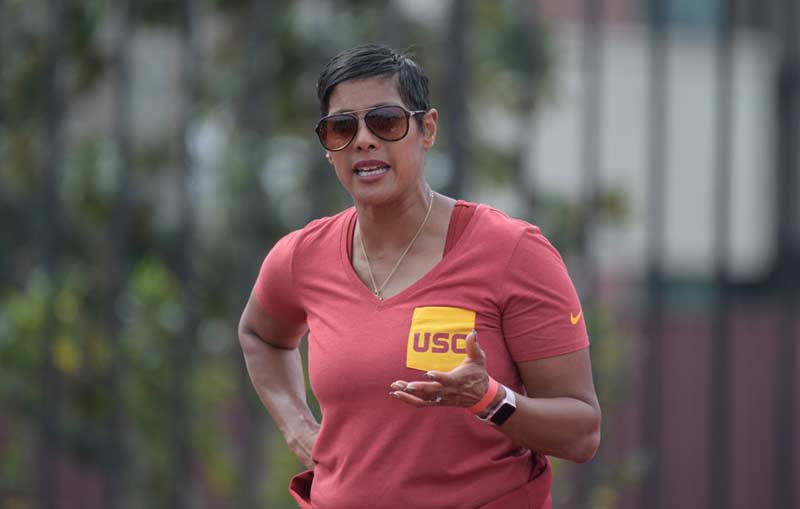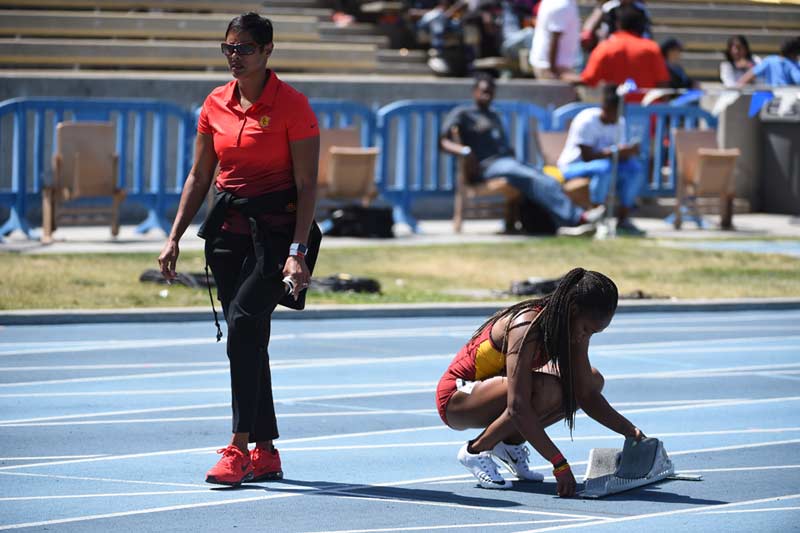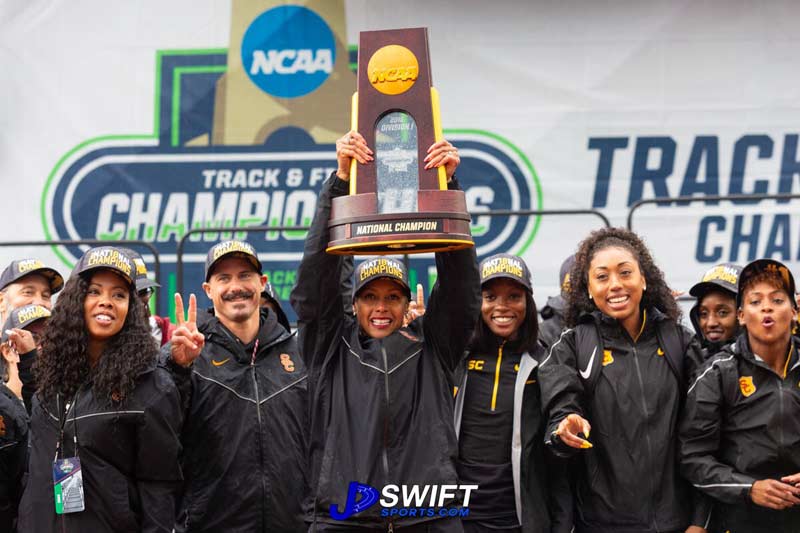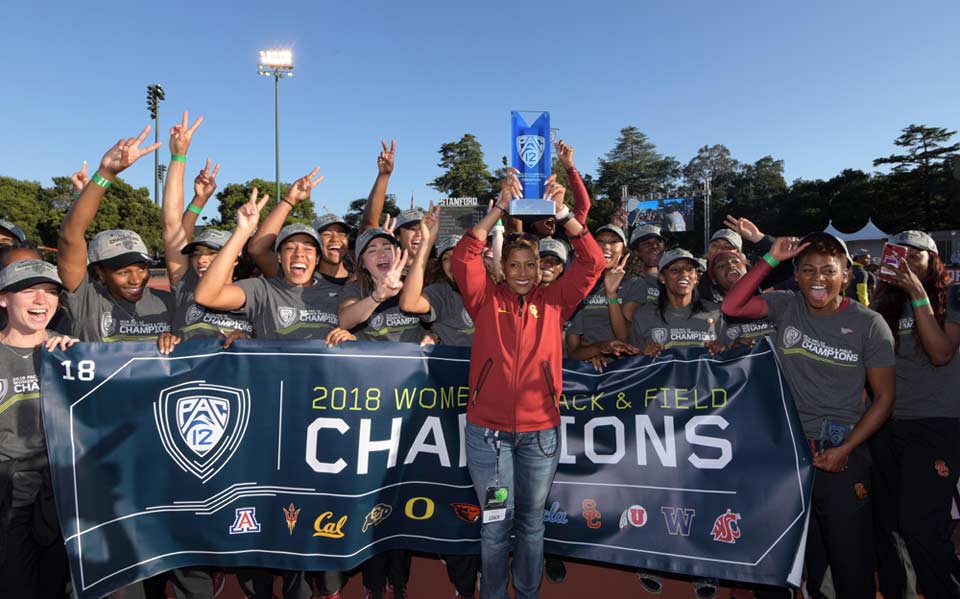The sun is already beginning to bear down at 9am in central Los Angeles, saturating the athletic complex at the University of Southern California with a lazy heaviness further exaggerated by the easygoing pace of a campus in summertime. A few swimmers can be spied gliding down their lanes at the Uytengsu Aquatics Center, but the diamond and grass at Dedeaux Field are silent and tented for a future catered event, and the most explosive activities underway at the Katherine B. Loker Track Stadium are courtesy of youth campers playing “hot lava” on square bricks beyond the entrance.
The off-season atmosphere, however, doesn’t dispel the ever-present weight of championship expectations. Olympic obelisks form columns at the entrance to the track, and along the stadium’s rear corridor, a hall of fame wall spans the length of a city block: row upon row upon row of placards honoring notable alumni from an institution that has produced 12 national titles on the baseball diamond, seven Heisman Trophy winners, and notable Olympians such as Allyson Felix, Lenny Krayzelburg, and Janet Evans.
The doors to the university’s track and field offices face that great wall of champions, and after entering with Caryl Smith Gilbert, USC’s Director of Track and Field, the first person to breeze by with a friendly handshake and hello is Quincy Watts, 400 m Gold Medalist at the 1992 Barcelona Olympics.
[av_button_big label=’More track and field:’ description_pos=’below’ link=’manually,https://1080motion.com/ato-boldon-1080-sprint/’ link_target=” icon_select=’no’ icon=’ue800′ font=’entypo-fontello’ custom_font=’#ffffff’ color=’theme-color’ custom_bg=’#444444′ color_hover=’theme-color-subtle’ custom_bg_hover=’#444444′ av_uid=’av-1bf2auw’]
Ato Boldon’s turn to coaching moves him outside the lanes of track & field
[/av_button_big]
Build Character First and the Body Will Follow
“I think that champions are made through character,” Smith Gilbert says as we settle into opposite sides of a conference table, perpendicular to a whiteboard scrawled with multi-colored tasks and communications for her coaching staff on both the men’s and women’s track teams. “You can’t have a championship mentality and not tell the truth, not be on time, not dress appropriately, not have integrity. Champions are on time. Champions are honest, because you have to be honest with what your weaknesses are in order to improve them, right?”
Smith Gilbert knows a thing or two about developing champions. The six-time Conference USA Coach of Year (University of Central Florida) took over the track program at USC in 2013, after training DeeDee Trotter for the athlete’s gold and bronze winning performances at the 2012 London Olympics. In 2015, Smith Gilbert became the first female coach to coach a men’s 100 m and 200 m NCAA Champion (Andre De Grasse), and this past June her women’s team battled through fierce competition and driving rain to win the NCAA Outdoor Championships at Hayward Field in Eugene, Oregon.

“The more detailed you become, the more professional you become,” she says, elaborating on how she instills a team culture built on personal accountability and a holistic work ethic. “The more detailed you become, the more skilled and technical your race becomes. The sprints are events that are so filled with details, and I think your life has to be just as detailed.”
How important are the little details? The National Championship in June was secured by less than 1/10 of a second in the competition’s must-watch closing event, with Kendall Ellis blazing down the final stretch of the 4X400 relay to pull out an absolutely stunning come-from-behind win, all the more extraordinary as that finish nudged USC a single point ahead of Georgia. The difference of only a split second, with Kyra Constantine, Anna Cockrell, Deanna Hill, and Ellis combining to run a 3:27:06 to Purdue’s second place 3:27:13, marked the first time in NCAA history the top three finishers in the championship were separated by just two points (USC with 53, Georgia at 52, and Stanford with 51).
In order to rise above and excel in any discipline—to transcend the baselines and norms—you first need a firm grounding in the fundamentals. For Smith Gilbert, the act of defying gravity in sprinting and jumping and throwing begins with a simple commitment to punctuality: start by being where you said you would be. Late for tutoring, study hall, or practice? Pay a fine that goes into a team fund for a post-season group expense. Miss an appointment with a massage therapist, PT, or tutor? Pay up.
“I just believe in showing them how life really works so they are accountable for what they do,” she says. “It’s very important that the coaches show that we care about them as people before you can start to implement these things. And they know that I care more about them in life and what they do past track and field or outside track and field, so that they know when we get to a crucial point in a meet or in a competition, that if I say you know you can win this, I’ve always told them the truth. Then at that moment, they know I’m telling them the truth because I wouldn’t say it if I didn’t really believe it.”
Strength—Speed—Overspeed
Step one: be where you are supposed to be. Step two: add strength. For Smith Gilbert, that foundation involves a distinction between absolute strength and elastic strength, and teaching her athletes how each quality impacts different elements of the race or competition.
“Weight room strength would be what I would call absolute strength,” she says. “You need to have weight room strength for the whole race, if we’re talking the one-hundred and further. But I would say past fifteen and twenty meters, my weight room strength isn’t as effective. I need my weight room for the start. People ask, what’s a block start? Well, a block start is reaction time, block clearance, and acceleration. About fifteen to twenty meters, wherever transition begins, past that point (the race) becomes elastic strength. That becomes my longer bounds. How well I get off the ground. How well I get out of the air. So my weight room is less effective for that, although I still need to be strong.”

Smith Gilbert’s programming includes short jump circuits, short jump runs, standing long jumps, power cleans, and deadlifts to build absolute strength, and an extensive range of bounding sequences to improve elastic strength. The next step from there is speed endurance—developing the ability to withstand the stacks of thirties, sixties, eighties, and nineties in the speed training program.
“After we get through the power, the elastic strength work, the speed endurance, and we get to pure speed, then I want to go into overspeed,” Smith Gilbert says. “The concept would be, if I want to run at 10 meters per second, if I can train at 11 meters per second and get my nervous system set up for that, then 10 meters per second is easy and maybe then I can run at 10.2 meters per second.”
Before she integrated the 1080 Sprint into her sessions, Smith Gilbert used to train overspeed with a human partner doing the towing. While the concept remained theoretically sound—pushing the athletes’ beyond their natural limits and training their central nervous systems to adapt to that higher speed—in practice she found issues with safety, consistency, and an all around discomfort with the process.
“With the 1080 I was able to come up with consistent measures, and I believe the athlete feels a lot more comfortable being pulled,” she says. “I have the same distance with the same load from week to week, and it tells me what their velocity is. It also times the release, so I can time from a certain distance. For me, I would time thirty. So it would pull them for sixty, but it would time the last thirty—or whatever I wanted—and I can get this apples to apples comparison every week with the exact same load.”
Athlete buy-in is the key—before the body can demonstrate its greatest expressions of power, the brain must feel safe. Trusting the ground beneath, trusting the coach, trusting the tools that will help them transcend the laws of physics.
“The athletes were able to feel the rhythm, they were able to feel what it feels like, that top-end maximum velocity of getting off the ground and getting out of the air the way that I wanted it,” she says. “I was even able to get to a point where they could tell me if they wanted it turned up or down based on how they were feeling. And they became more comfortable with the machine pulling them and it was actually… it used to be when we did assisted, they didn’t want to do it. Because it was too uncertain. But they became comfortable and I could get more consistent workouts planned because they would do it. They felt, okay, if today I don’t feel like I’m comfortable being pulled at a certain number, it’s okay if I back down and we can still get the work done. So that was the best thing about it.”
A Study in Contrasts
“For one part of the contrast training we would go two (sets) with the 1080 and one without,” Smith Gilbert says, continuing to discuss the progressions in her training program. “We’d time the fly thirty with the 1080 so I could see what the maximum velocity would be for thirty meters—we’d run thirty, time the last thirty. Then I’d do two of those with the 1080 and one without so I could see the difference between the velocity with it, and the velocity without it. That allowed me to see how much of an effect it had on the nervous system. That’s one part of our contrast training. The other part, we would go resisted for twenty meters, then assisted for thirty. That just helped so that they could feel the race pattern more naturally than not.”
Contrast training methods often pair components of absolute and elastic strength, such as using a foundational lift (deadlift, squat, etc) to potentiate an explosive movement (broad jump, med ball throw, etc). Emphasizing the little details that characterize championship performances, Smith Gilbert applies the concepts of contrast training on the track in order to mimic the demands of the race itself.

“I actually came up with something where we could go resisted for thirty, turn it around and go assisted for thirty the next set,” Smith Gilbert says. “It allowed me to also get them the feeling of acceleration, and then turn around and go maximum velocity in one workout. So they could feel the drive phase, and then I could turn around and say okay, you drove out, and now I want you to turn around and feel the other part of the race.”
Change as a Constant
Teaching athletes to defy gravity and take flight is one thing; they also must be able to land. Guiding students who face a diverse range of social, academic, and physical stressors in their lives, Smith Gilbert has grown more flexible as she’s advanced in her coaching career. This has meant adapting and individualizing her programming to meet the daily, always-changing needs of every athlete. Leading her staff—Joanna Hayes (Sprints & Hurdles), Patrick Henner (Distances & Cross Country), Dan Lange (Throws), Quincy Watts (Sprints), Kyrah McCowan (External Operations), and Amanda Decker (Internal Operations)—Smith Gilbert directs each coach to work with athletes of both genders, inspiring them to be equally flexible and open in their approach.
“We meet once a week, every Monday, to go over each person and what they need to do,” Smith Gilbert says, talking about ensuring the sustainability of her macrocycle and periodization plan. “Sometimes, maybe even on a daily basis, we look at each athlete to see what needs to change, because maybe we wrote them in on a certain group, but something might be going on with them where they have to do something different.”
[av_button_big label=’Next post:’ description_pos=’below’ link=’manually,https://1080motion.com/indiana-football-matt-rhea-speed/’ link_target=” icon_select=’no’ icon=’ue800′ font=’entypo-fontello’ custom_font=’#ffffff’ color=’theme-color’ custom_bg=’#444444′ color_hover=’theme-color-subtle’ custom_bg_hover=’#444444′ av_uid=’av-u9u80o’]
Speed 101 With Dr. Matt Rhea and Indiana University Football
[/av_button_big]
Coach Smith Gilbert provides a practical example, during which the written plan might dictate that everyone is performing 3 X 9 Hurdle Hops. Within that, however, there will be an advanced group performing their sets on higher hurdles while wearing a weight jacket; an intermediate group might also wear the weight jackets, but use lower hurdles; and a beginning group of freshman might perform their sets on lower hurdles without the added weight.
“We have them do the same thing, yet it will be different, depending on where they fall and what’s going on. We vary it all the time depending on who you are and what you’re doing—it’s more general early, but as we get later it breaks down to person by person,” Smith Gilbert says. “You can’t be a slave to the paper. Meaning, it’s all on paper, but you can’t be a slave and think it has to happen. No, it has to change. The paper is the goal—that would be great if it could all go according to the model. But it doesn’t. So, you have to use mother-wit and change and move and be flexible to what’s on the paper to get to where you need to be.”
Getting where you need to be? Start by being where you said you would be. Add strength and technique. Adapt to change. And then that place you need to be will be where you want to be—crossing the finish line. Faster.






























































